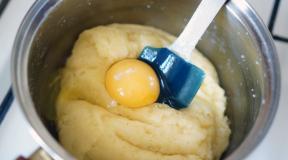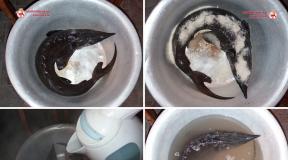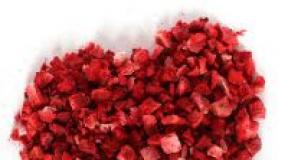Salting green tomatoes in a cold way in a bucket. Salting tomatoes in a dry cold way
It seems to me that there is nothing tastier from pickles than huge barrel tomatoes - scarlet, fleshy, sweet, ready to explode right in your hands.
I can eat such tomatoes just like that, about five - I’m all over my elbows, but I’ll take my soul))
Of course, the most delicious tomatoes are obtained only from the grandmother in the village, in a real oak barrel, which is stored in a cool cellar, where it is dark and smells of dampness.
And it always seemed to me that without exactly the same barrel and an old cellar, it was impossible to cook such, well, or at least remotely similar in taste, tomatoes.
And I was wrong again - you can! The main thing is to have a cool cellar (+10 degrees) and you don’t even need a barrel!
If you can do without a barrel (I’ll tell you how now), then without a cellar, this whole idea with tomatoes almost makes no sense - while the tomatoes are salted, special fermentation processes take place inside and the very umami taste is produced (a finely balanced combination of sweet, salty, bitter and sour, it is because of this umami taste that we like sauerkraut, salted milk mushrooms, anchovies or jerky so much). And the larger the volume of dishes in which the product is salted / fermented, the faster and more smoothly the processes go.
Therefore, in fact, pickled tomatoes in a bucket will turn out to be an order of magnitude tastier than the same pickled tomatoes in a jar. Well, putting a whole bucket in a regular refrigerator is an unaffordable luxury.
So look for a cellar, or you can deceive fate and make it according to a different recipe that can be stored in a city refrigerator.
In addition to the main characters of tomatoes, we still need a lot of any spicy greens from the garden - horseradish leaves, black currants, cherries, dill umbrellas, a whole parsley bush (with leaves and roots), garlic with green feathers, mint.
You can choose spicy herbs to your taste (someone loves parsley, and someone can’t stand mint), and if you don’t have your own garden, go to the market, where grannies sell ready-made fragrant “brooms” for 20-50 rubles salting.
What is the best way to pickle tomatoes?
The most ideal dishes for salting are special oak barrels. Now you can buy them in specialized online stores or craftsmen will make them to order. Such barrels only get better and more fragrant over time, but require constant care - a fungus readily settles in the wood and mold starts, a barrel cannot be placed on a bare floor (there must be ventilation between the floor and the bottom), such a barrel cannot be washed with detergents and generally exposed to any chemistry, and in the spring and summer, while the barrel is standing without pickles, it is filled with water so that the tree does not dry out, and a couple of times a year you need to tighten the hoops. As you can see, there are more than enough difficulties.
The second most popular dishware is enameled buckets/pots/jars. The enamel does not react with the brine (it will not have a metallic taste), it is convenient to wash such dishes, but the lids usually do not fit tightly, and sooner or later mold will appear on the surface of the brine, which will have to be constantly cleaned.
The same story with ceramic pots and kegs, besides they are quite heavy and not resistant to impact. But to them you can pick up (turn) a dense cover made of wood.
The most ideal is glass three and five liter jars. Glass also does not absorb odor and is easy to keep clean. Through the transparent walls you can clearly see what is happening inside the jar, there are no problems with tight lids now (there are different sizes and colors on sale), it is convenient to rearrange the jars from place to place. But the main problem that can lie in wait when using such dishes is that the neck is too narrow and large tomatoes (and they are the most delicious and meaty) simply will not crawl inside!
Therefore, my choice is plastic buckets, which I buy at a wholesale base where they sell disposable tableware, packaging, paper napkins, bags and boxes for cakes.
Such buckets come in different sizes (from 0.5 liters to 12!), are inexpensive (about 30 rubles for a 3 liter bucket), the walls are transparent enough to observe the processes and the level of the brine, the lid is 100% sealed and nothing will spill (which always happens with three-liter jars). A three-liter bucket is much lower than a can of the same volume, it is convenient to place it on the shelves of the cellar or store it in the refrigerator. Well, the bucket itself is wider than the can - you can put the tomatoes in it as tightly as possible.
The only negative is that plastic strongly absorbs odors, so once you pickle tomatoes in such a bucket, you will have to use it only for pickling))
At the bottom of the bucket we put a couple of horseradish leaves, currants, a few cloves of garlic, a dill umbrella - that’s the fragrant “pillow” for tomatoes is ready.
But first of all, let's boil the brine.
The composition is simple - water, non-iodized (!) coarse (salting) salt and a little sugar, which will speed up the fermentation process.
The proportions of salt and sugar here can be any, but water with dissolved salt should seem a little salty.
I usually take 3 tablespoons of salt and 2 tablespoons of sugar for a three-liter jar of tomatoes.
It’s more difficult with water)) My advice is to put the tomatoes loosely in a jar / container for pickling, pour cold water (as much as you like), and then drain the water and measure its volume, and then calculate in jars how much brine is needed.
If you make a lot of blanks at once, then it is reasonable to cook a whole bucket of brine.
Mix water with salt and sugar, add your favorite spices - peppercorns, bay leaf, dill seeds (you can buy at the pharmacy if you don't have your own garden), cumin (sold in any supermarket).
Boil the brine and cool to room temperature.
In the meantime, it cools - we are engaged in tomatoes.
We wash them thoroughly, wipe them dry, and examine them from all sides - we need the most beautiful and ripe specimens. If the tomato has an unripe barrel, then it will remain unripe and hard, if the peel has burst, then after pickling it will be impossible to get such a tomato - it will simply fall apart in your hands. Well, no spoiled tomatoes!
A small life hack - with a thick needle we make several punctures in the area of \u200b\u200bthe stalk so that the tomatoes are salted evenly and quickly. The brine will enter through the holes, and air will come out through them, which will appear during fermentation and the tomato will not break.
We put the tomatoes tightly in a bucket, and when we fill it halfway, you can add a few more sprigs of parsley and currant leaves.
We also put spicy leaves and garlic on top, cover with a sheet of horseradish, poking it from all sides (even if mold appears in the bucket, just carefully remove the top horseradish leaf).
And pour strained and cooled brine to the top.
We don’t close the lid yet, put an inverted plate on top, and on it - a small load (for example, a pack of 400g cereals) - this is necessary so that the tomatoes are all covered with brine.
* If you make such tomatoes in glass jars, then use a small stone wrapped in cling film or a bag as a load.
To make sure nothing leaks, buckets can be placed in basins, large plates, on a baking sheet or tray.
And we put this design in a dark place with room temperature. If it is too warm, the tomatoes will quickly ferment, and we do not need to speed up the process. If it is cool, they may not ferment at all, but simply turn sour in a few days and everything will have to be thrown away.
The usual room temperature of 18-22 degrees is normal.
*by the way, there are wandering in the background))
And now it remains only to wait!
In the heat, the tomatoes will ferment on the third day - the brine will become cloudy, and when pressed on the plate, bubbles will appear.
A white film (white mold) may appear on the surface. I cleaned it with a spoon and a napkin (then, as I said, before tasting, you can simply remove the top sheet of horseradish - all the mold will remain on it).
They say that you can pour mustard powder on top (and mustard grains will do) - this prevents mold from growing, and the tomatoes become even more vigorous. From personal observations - I poured mustard into some of the buckets, not into others, mold appeared everywhere, but with mustard, yes, it was less. It didn't affect the taste or smell.
After the tomatoes ferment, we leave them warm for another five days (by the way, it is convenient to sign the pickling date and control numbers on plastic lids), and then tightly close the lids and put them in the cellar with a temperature not higher than +10 degrees Celsius, or in the refrigerator (if space permits).
You can eat right away, but it’s better to let the tomatoes stand for 1-1.5 months - every day they become tastier. If you store in the refrigerator, keep in mind that it is unrealistic to endure a whole month - they smell! And every day the brine becomes more and more transparent, and the tomatoes brighter - you like it, you don’t want it, but you constantly stick your nose in the bucket “for a test”!))
But if you endured, you will be rewarded!
Tomato pulp inside will turn into a delicious spicy juice. Look at the light, the tomato is almost transparent, elastic, inflated, full of liquid.
From the first bite, the tomato explodes on the tongue with a fountain, the juice flows down the chin and elbows, drips onto the boiled potatoes (all these pickles are especially good with ordinary potatoes), and the hand reaches for the second tomato ...
No, I still think that the most delicious tomatoes are from our grandmother's cellar, but this recipe is very, very successful!
And there is something magical in this - he will go down to his cellar with a deep plate and a large spoon, pick up vigorous tomatoes from a bucket for dinner, remember that there is an ice-cold bottle of alcohol in the freezer, call his friends, and call for a bath!
Ehhhh, enjoy!
*And if you don’t have the strength to wait so long to take a sample, make barrel cherry tomatoes - you can feast on it in 2 weeks!
Dill greens - 10 g
Garlic - 3 cloves
Black peppercorns - 5 pcs.
allspice - 5 pcs.
Bay leaf - 2 pcs.
Horseradish leaves - 1 pc.
Currant leaves - 3 pcs.
- 20 kcal
- 12 noon
Cooking process
Tomatoes, salted in a bucket or barrel for the winter, were not so long ago common everywhere in the villages. These are the most delicious and healthy tomatoes - they ferment due to the resulting lactic acid, have a slightly harsh sweet and sour taste. Such tomatoes are an excellent snack for boiled potatoes, kebabs. They have one drawback - they “puff” too quickly, i.e. lose elasticity, fill with gas and burst, therefore, by opening a bucket or a jar. Such tomatoes should be eaten as soon as possible - preferably on the first day.
When the tomatoes were salted in barrels, they simply went down to the cellar or cellar, where they were kept cool, collected the tomatoes in a cup, and the rest were again covered with gauze and a wooden circle - they were always, as if only cooked. In the conditions of a city apartment, for preparing salted tomatoes for the winter in a bucket, I recommend taking small plastic buckets for salting.

For salting, we will prepare strong, slightly unripe, tomatoes, dill, garlic, peppercorns, bay leaf, horseradish and currant leaves, salt and water.

Let's make a pickle first. Boil water, take salt, depending on the size of the tomatoes - 1-2 tablespoons. If the tomatoes are large, then more brine will remain between them, which means that more salt is needed. Immediately add bay leaf and peppercorns to the water. Boil the brine and put it to cool in a cold place - on the balcony, for example.

Prepare plastic buckets - rinse them well and dry them, rinse the tomatoes and greens. Let's also let the water drain.

We put a chopped horseradish leaf, currant leaves on the bottom in a bucket (if you are salting in the fall, at a later time you can take dried herbs or get by with what you have), dill greens, chopped garlic.

Then we pierce the tomatoes with a toothpick at the base of the stalk - this will allow the tomatoes to salt more evenly, they have a very dense peel. We fill the free space with greens and cloves of garlic - they will also turn out delicious.

Fill with slightly warm or completely cooled brine.

We close the tomatoes with lids, you can put oppression for the first 1-2 days. When the fermentation process has passed - after 3-4 days (this will be noticeable by the turbidity of the brine and the absence of bubbles), take the pickled tomatoes in a bucket for the winter to a cold place - to a permanent storage place.

After a week and a half, you can try (you can try earlier, salted tomatoes are also very tasty!).
How to pickle tomatoes in a bucket?
Salted tomatoes are unlikely to ever lose their popularity among our compatriots. On the contrary, every year salting recipes are improved. And not only our grandmothers are already doing this, but also all lovers of cooking, wanting to treat themselves and their families to something delicious.
Why in a bucket?
 Canned tomatoes don't taste as good as they do in a bucket or barrel. The thing is that preservation involves only one taste of these vegetables, but salting is many. Thanks to the fermentation process, tomatoes can be eaten at all stages of their salting. At first they will be lightly salted, then their taste will begin to gain momentum, and now you have incredibly spicy and tasty, almost vigorous, tomatoes!
Canned tomatoes don't taste as good as they do in a bucket or barrel. The thing is that preservation involves only one taste of these vegetables, but salting is many. Thanks to the fermentation process, tomatoes can be eaten at all stages of their salting. At first they will be lightly salted, then their taste will begin to gain momentum, and now you have incredibly spicy and tasty, almost vigorous, tomatoes!
Recently, the cold method of cooking has become quite popular. Housewives do not always have time to mess with hot brine, especially in large quantities, and such tomatoes turn out to be no less juicy and tasty. By the way, they retain much more useful substances when salted than canned and heat-treated.
In addition, it is much more convenient to pickle a large number of tomatoes for the whole family in a bucket. Even 10 three-liter jars will take up quite a lot of space, but relatives will want a lot of delicious pickles in winter.
How to choose tomatoes for pickling
You can salt any variety and color - red, brown, green. Even cherry tomatoes will do, however, the container will need to be taken smaller. Focus here on which of them you and your family like best to taste.
However, many advise using the Cream variety. Firstly, the variety is one of the most popular, and secondly, it contains a lot of dry matter, so it is ideal for any type of processing - pickling, pickling or preservation.
 Be sure to make sure that there is no white core inside the vegetables. Otherwise, the salting will not be as tasty and of high quality as you expect.
Be sure to make sure that there is no white core inside the vegetables. Otherwise, the salting will not be as tasty and of high quality as you expect.
Also proceed from the hardness of the tomatoes. For example, salting red ones - you will get soft tomatoes, the juice of which will immediately flow down your hands. If you like hard ones, then salt the green ones. Even in the last stages of salting, they will not lose their hardness, but the taste will be no worse than that of red or brown ones.
The main thing is not to mix all types of tomatoes in one container. If in preservation it will look beautiful and interesting, and the difference in taste will be minimal, then with pickling it is the other way around: red, brown and green tomatoes have different cooking times. Therefore, the salting will be rather strange at the end and the jump in taste will be too big.
Salting and pickling recipes
It is very difficult to catch the line that separates salting and fermentation. Salting is the storage of products in a saline solution, and fermentation is a cross between salting and preservation with the help of biological, i.e. lactic acids.
Many recipes now have signs of both fermentation and salting, so the difference in cooking tomatoes in these ways is not at all fundamental.
As noted earlier, we will pickle in a cold way, since it will take less time, and the taste will be good, and the tomatoes will not lose their useful qualities.

To begin with, it must be said that the dishes themselves must be thoroughly washed, even if they were completely clean and no one touched them. A controversial statement, because microbes do not care.
Rinse tomatoes and peppers under running water. Remove any wrinkled, overripe vegetables immediately and set them aside. They are not suitable for salting, but for ketchup or adjika - ideal.
Fresh herbs also need to be washed thoroughly.
What should be green? Well, it’s hard to give a specific answer here, since every housewife uses a proven set for years, “gotten” to her by recipes from grandmothers and mothers. If you are cooking for the first time, then you can take the following set: dill (twigs should be together with umbrellas), celery, parsley, bay leaf, cherry, currant and horseradish leaves.
Now we thinly cut the entire green set, except for the leaves, to a match length and about the same thickness. Mix it to get a homogeneous green mass. We spread it on the bottom of the bucket so that it is completely closed. Add a couple of bay leaves, the same number of clove buds, 2-3 peas of allspice and 8-10 black peas. Chili peppers can be cut into pieces, but it is not necessary.
Let's start preparing the brine. Assume that a container of, for example, 10 liters of brine will need about 5 liters. However, do more so that you can fill the bucket to the brim. We dissolve the required amount of salt (for the same 5 liters of water 10 tablespoons) in water and fill the bucket with brine.
Lay a wooden circle on top, press it down with something and cover with a napkin. Let the tomatoes stand at room temperature for a few days to start the fermentation process, and then put them in a cold place.
After about 2 weeks, start tasting your pickle.
Salting tomatoes in a bucket: recipes for cold salting
Canned tomatoes don't taste as good as they do in a bucket or barrel. The thing is that preservation involves only one taste of these vegetables, but salting is many.
Recipe for pickling tomatoes (cold way)
 Tomatoes for the winter are an indispensable and beloved type of preparation by many. There are many ways to prepare tomatoes for future use - tomatoes are salted, pickled, sour, made in their own juice, dried. Never bought canned tomatoes can compare with fragrant home-made, prepared with love. Today I will show you a recipe for pickling tomatoes, which has long been a favorite in my family - pickled tomatoes in a barrel. Don't worry, you don't have to buy a 200 liter wooden barrel) I salt tomatoes in a plastic 30 liter barrel in a cold way, you can also make these tomatoes in ordinary jars, the main thing is not to spare seasonings, and in a month you will enjoy delicious, mouth-watering, natural homemade tomatoes.
Tomatoes for the winter are an indispensable and beloved type of preparation by many. There are many ways to prepare tomatoes for future use - tomatoes are salted, pickled, sour, made in their own juice, dried. Never bought canned tomatoes can compare with fragrant home-made, prepared with love. Today I will show you a recipe for pickling tomatoes, which has long been a favorite in my family - pickled tomatoes in a barrel. Don't worry, you don't have to buy a 200 liter wooden barrel) I salt tomatoes in a plastic 30 liter barrel in a cold way, you can also make these tomatoes in ordinary jars, the main thing is not to spare seasonings, and in a month you will enjoy delicious, mouth-watering, natural homemade tomatoes.
We will need:
- tomatoes
- dill sprigs (together with umbrellas)
- parsley, celery
- garlic
- Sweet pepper
- black peppercorns
- allspice peas
- Bay leaf
- currant, horseradish and cherry leaves
- boiled and chilled water
- sugar
In a bucket of cold water, take 2 cups of salt and 1 cup of sugar.
Cooking:
Wash tomatoes thoroughly and sort. Put aside overripe and crushed tomatoes, they can be used for adjika. For salting, we prefer to take small, dense, fleshy cream.

Peel the onion, wash and cut into rings. Peel and rinse the garlic. Wash the sweet pepper, remove the stalk and seeds. All greens are also thoroughly washed.
At the bottom of a barrel or bucket, lay out a layer of spices, onions, garlic, sweet peppers, bay leaves, peppercorns, etc., lay a layer of tomatoes on top and repeat all the layers to the very edge.

There should be a lot of spices, the taste and aroma of our salted tomatoes will depend on this.

We make pickle for tomatoes from boiled and chilled water. In a bucket of cold water, take 2 cups of salt and 1 cup of sugar. Pour this brine over the tomatoes. We cover with gauze on top - mold will collect on it, so the gauze must be changed periodically.
If you salt the tomatoes in a bucket or in a saucepan, then a plate or a large dish in the form of a load is still laid out on top. In my barrel, the neck is small, I just fill it “to the eyeballs”, there are a lot of greens on top, then gauze and a lid.

We lower the barrel into the basement, into the pantry or onto the balcony. After three to four weeks, you can take a sample. They are eaten very quickly with us, they practically do not survive until the winter))
Recipe for pickling tomatoes in a barrel or bucket (cold way)
Today I will show you a recipe for pickling a tomato, which has long been a favorite in my family - pickled tomatoes in a barrel.
Salted tomatoes in a bucket

Ingredients:
Ripe tomatoes 4-5 kg depending on size.
Hot red pepper 2 pieces.
Salt 500-700 grams.
Cooking:
Wash the tomatoes well. Wash the dill greens. Cut the garlic (1 head) into plates. Cut a couple of pieces of red hot pepper in half, after carefully peeling it from the seeds.
At the bottom of a bucket of 10-12 liters, put dill, a few cloves of garlic and red hot peppers. Then lay ripe tomatoes on top, alternating them with dill and garlic.
So put in a bucket about 4-5 kg of tomatoes, depending on the size. Do not report about 10 cm to the very top. Cover the tomatoes with dill greens from above.
Then pour 500-700 grams of salt into a 5-liter bowl. Pour cold tap water over it and stir well.
Then pour the tomatoes in a bucket with this salt water. Put a plate on top, put a load of a 3-liter jar of water on it approximately.
So the tomatoes should stand for 10-14 days until they become salty. They will be salty as if from a barrel.
Salted Tomatoes in a bucket recipe
So the tomatoes should stand for 10-14 days until they become salty. They will be salty as if from a barrel. Yummy! I advise everyone to cook, you will not be disappointed! Ripe tomatoes 4-5 kg, depending on
How to pickle tomatoes in a bucket like a barrel
Various snacks are prepared from tomatoes, but salted vegetables are the most popular. It is salting that gives them an unusual and piquant taste, and at each stage of salting is different.
Thanks to the fermentation process, at the initial stage, tomatoes become lightly salted, then spicy with a pronounced taste, and at the very end of cooking - rich and vigorous. Such a versatile appetizer is suitable for meat, poultry, fish and any side dish.
How to cook delicious pickled tomatoes in a bucket - our selection of recipes.
1. Cold pickling of tomatoes without vinegar

It is this method of cooking that will allow not only to get a tasty product for the winter, but also to preserve all the useful properties and taste of vegetables. How to cold pickle tomatoes in a bucket, see the detailed instructions below.
So, for this you will need:
- green tomatoes - 1 bucket without a slide;
- salt (5 liters of brine will require 10 tablespoons);
- sugar (2 tablespoons per 6 kg of tomatoes);
- hot pepper capsicum - 5 pcs.;
- parsley greens - 1 large bunch (two can be);
- garlic - 6-7 cloves;
- black peppercorns - 8 pcs.
You can pickle green tomatoes not only in a bucket, but also in a barrel, a tub, a saucepan (enamelled only), whoever has what they have at hand. In any case, the dishes should be clean, and for this it is better to wash and pour boiling water over them.
After that, you can take on the tomatoes. They need to be washed well. Set aside soft tomatoes and fruits with damage, they are not suitable for pickling.
Rinse the parsley and chop finely. By the way, according to this recipe, you can use any greens and combine it with other additives - bay leaves, cherry leaves, dill, celery.
Place finely chopped greens on the bottom of the prepared container, put a couple of bay leaves, a few peas of allspice and a dozen peas of black pepper on top.
Next comes the vegetables. Tomatoes need to be laid so that there is a little space left on top - 2-3 cm from the top of the container. A ten-liter bucket will require about five liters of brine, but it is better to make a little more so that it is enough to completely cover the tomatoes.
Cover the brine-filled tomatoes with a lid and put oppression on top, for example, a heavy stone. Two weeks after preparation, salting can be tasted.
2. Salted barrel tomatoes with horseradish for the winter

This recipe is designed for a capacity of 30 liters. To pickle tomatoes, as in a barrel, you will need the following composition of ingredients:
- horseradish - 10 medium sheets;
- tomatoes - 18-20 kg;
- salt - 60 g (3 tablespoons) per 1 liter of water;
- garlic - 1 large head;
- blackcurrant sheets - 25 pcs.;
- cherry leaves - 25 pcs.;
- dill umbrellas - 10 pcs. (dill seeds - 50 g);
- hot pepper - 1-2 pods;
- tarragon - 8-10 shoots with leaves;
- purified water - 15 liters.
First you need to prepare the container for salting - rinse it thoroughly and dry it. Then wash all the vegetables, herbs, peel the garlic from the husk.
The laying of vegetables according to this recipe is done in layers - vegetables-spices-vegetables. Horseradish leaves are placed at the very bottom, then greens, spices and tomatoes on top. It is better to put large tomatoes on the bottom, and fill the voids between them with small vegetables.
When you reach the very top, leave some free space so that the tomatoes are completely in the marinade, and they can be covered with a lid. The last layer of vegetables should be covered with horseradish leaves.
It remains the case for small things - to make a brine and pour vegetables over them. Dilute salt in water in the ratio indicated in the recipe and pour tomatoes with brine. For a thirty-liter container, you will need at least fifteen liters of ready-made brine.
Cover the pickle with a clean gauze cloth on top, then place a plate on top and transfer the pickle to a cool place for fermentation.
After a couple of weeks, delicious, salty tomatoes with garlic and pepper can be tasted.
3. Salting tomatoes with carrot tops

To prepare such an appetizer for the winter, you will need:
- small brown tomatoes;
- water - 5 liters;
- carrot leaves;
- apple cider vinegar - 2 cups (can be replaced with 1 cup table 9% vinegar);
- sugar - 1 cup;
- allspice - 10 peas;
- lavrushka - 3 leaves;
- salt - 100 g (5 tablespoons).
For salting, you need a three-liter glass container. Rinse the bottles, rinse with boiling water and dry. Wash the tomatoes, rinse the carrot tops.
Place three sprigs of carrot tops on the bottom of the bottles, lay the tomatoes tightly. Put a pot of water on the fire, boil and pour vegetables with boiling water. After five minutes, drain the water into the sink.
Measure out five liters of water and pour into a saucepan, add salt, sugar. Bring the marinade to a boil, add vinegar, parsley and pepper. Pour boiling marinade over vegetables to the top and roll up with sterile lids.
Ready salting should be well wrapped and after cooling it can be taken out for storage in the basement or put in the pantry.
4. Salted tomatoes with mustard in a saucepan

How to make such salting at home? So, take:
- medium-sized brown tomatoes - 8-9 kg;
- water - 5.5 l;
- blackcurrant leaves;
- salt - 180 g;
- a mixture of peppers - 5 g (half a teaspoon);
- lavrushka - 6 leaves;
- mustard powder - 10 teaspoons with a slide;
- ground hot pepper - 1/2 teaspoon.
So, we put all the spices in a clean container at the bottom, put the tomatoes on the parsley, shifting each layer with currant leaves. Bring water to a boil, add salt.
As soon as the dry ingredient dissolves, remove the brine from the heat, let it cool, add the mustard and pour the marinade over the vegetables to the top.
Cover the top with a lid and set aside.
In ten days, the spicy mustard appetizer will be ready to eat.
5. Stuffed tomatoes per day

- cream tomatoes - 2 kg;
- team greens (dill, parsley, basil, cilantro and celery);
- garlic - 1 large head;
- table or apple vinegar - 80 g;
- lavrushka - 2 pcs.;
- allspice - 10 peas;
- hot pepper - 5 pods;
- coriander seeds - 2-3 pinches;
- cloves - 4 buds;
- salt - 2 tablespoons with a slide;
- sugar - 3 tablespoons (can be replaced with honey).
Peel the garlic, chop finely with a knife.
Rinse the greens finely chop. Combine chopped ingredients, mix well.
Rinse the tomatoes, make a longitudinal incision in each fruit. Coat the inside of each vegetable with stuffing.
Put a saucepan on the stove, pour in water, add all the ingredients, except for honey. Boil the finished marinade, cool a little, add honey, stir and pour tomatoes over it.
Close the blanks with nylon lids, leave warm for a day, and then transfer to storage in the refrigerator.
Stuffed tomatoes can be tasted the very next day after cooking.
6. Salted tomatoes with grapes (Bulgaria)

The easiest way to salt is in 3-liter jars or small buckets made of food-grade plastic. In Bulgaria, this is done in large ceramic pots. Grapes should be taken table varieties: white or pink.
- medium-sized tomatoes (as many as you like);
- 1 bunch of grapes (with a brush);
- 1 bell pepper;
- 1 small hot pepper;
- 5 cloves of garlic;
- 2 laurels;
- 5 sheets of cherries and currants;
- half a sheet of horseradish;
- on a sprig of dill and parsley;
- 10 peppercorns;
- 3 cloves;
- 1 tbsp. topped with salt and sugar.
The process is simple: wash the jars well, pour boiling water over them. Put tomatoes in them, interspersed with grapes, herbs and spices, add salt and sugar, hot pepper should be from the very top - this will not allow the contents to ferment.
Pour boiling water over the jar, cover with a lid and leave until almost completely cooled. Then drain the marinade, bring to a boil, pour again and immediately cork.
Salted tomatoes in a bucket: the most delicious recipes
The taste of barrel salted tomatoes cannot be confused with anything. We offer you recipes for pickling tomatoes according to old and modern recipes in a bucket and in a saucepan.
Be honest, do you know how to salt tomatoes for the winter? Salting a tomato for the winter is a very simple and not laborious process, but not all hostesses get delicious salted tomatoes for the winter. And today, dear friends, I want to tell you about the recipe for salted tomatoes in jars for the winter, which my grandmother has been using for more than 50 years.
I tried a variety of salted tomatoes for the winter in a cold way: from the market, from the supermarket, visiting other hostesses, but my grandmother's salted tomatoes under a nylon cover for the winter remain the standard of quality for me. Grandma's recipe for delicious pickled tomatoes for the winter is to use a certain set of spices and roots, as well as the ideal ratio of salt and water.
There is nothing tastier in the world than salted red tomatoes for the winter in jars, with mashed potatoes and rich pork goulash ... As if yesterday I was a little girl, and my grandmother told me how to salt tomatoes for the winter in jars. I helped her with interest, and the maximum that I was instructed to do was peel the garlic and wash the jars for the tomato.
Today, my little daughter helped me cook salted tomatoes for the winter in jars in a cold way. She was insanely interested in filling jars with tomatoes and laying out spices. But most of all she wanted to know: why you can’t salt Lego with tomatoes
I hope I convinced you to cook delicious pickled tomatoes for the winter? Then welcome to my kitchen, where I will tell you in detail how to pickle tomatoes for the winter simply and tasty.
Ingredients for pickling tomatoes:
- tomatoes
- parsley root
- horseradish root
- carrot
- garlic
- black peppercorns
- hot peppers in pods
Brine:
- 1 liter cold water
- 1 tbsp salt with a slide
How to salt tomatoes for the winter in jars:
The most time-consuming part of preparing salted tomatoes for the winter in jars is the preparation of ingredients for salting. I salted five liter jars at a time, so I had to work hard. We clean the garlic, at the rate of 5-6 small cloves per 3-liter jar. We also clean and cut carrots, parsley root, horseradish root. Do not forget to prepare hot pepper pods, black peppercorns and parsley.

Next, lay out the prepared ingredients in clean jars. I added all the spices “by eye”, but if you are preparing salted tomatoes for the winter in jars in a cold way for the first time, it is better to follow the golden mean and use the following proportions per three-liter jar:
- 5-6 cloves of garlic
- 5 black peppercorns
- 50 grams parsley root
- 50 grams of carrots
- 3-4 pieces of horseradish root
- 2-3 sprigs of parsley
- 1-1.5 pods (small) hot peppers

Following the spices, fill the jars with washed tomatoes. In the process of laying, the jars need to be shaken so that the tomato fits as much as possible. We put large tomatoes at the bottom of the cans, and we put small tomatoes closer to the neck. I will not advise varieties of tomatoes for pickling, because I know little about them. The main thing is that the tomatoes are small, fleshy and with a thick skin.

Next, we will prepare a brine for our future salted tomatoes in jars: we dilute one tablespoon of salt with a slide in one liter of cold running water. Salt is needed rock, and in any case not iodized.

Fill the jars with tomatoes with brine up to the neck to the level of the strips.

At the next stage of salting the tomato, we cover the jars with nylon lids, and remove the jars of tomatoes in a dark, cool place for storage - in the cellar, or in the refrigerator. After 10 days, the brine in the tomato jars will become cloudy, and fermentation will be almost over.
At this stage, you need to pour one tablespoon of vegetable oil into each jar of tomatoes so that a white crust does not form. Fully salted tomatoes for the winter in jars will be ready to eat in 40-45 days.

Salted tomatoes for the winter in jars in a cold way have one significant drawback: jars with salted tomatoes must be stored in the cellar or in the refrigerator. Salted tomatoes are prepared for the winter without vinegar and without sterilization, so they will not survive storage at room temperature. But even if you don't have a cellar, I highly recommend that you prepare at least one jar of these delicious pickled tomatoes and store them in the refrigerator.
You yourself will be surprised how quickly these salted tomatoes disperse. Also, if you liked my recipe for salted tomatoes for the winter in a cold way, you can pickle tomatoes at the end of September, when there is no heat anymore, and store jars of salted tomatoes on a glazed balcony until the first hard frosts.
There are different ways to harvest a tomato for the winter. They are marinated, frozen, dried and, of course, salted. Salting is an easy way to improve the taste of vegetables and extend their shelf life. It is cold and hot, carried out in different containers.
To keep the blanks as long as possible, they are hermetically sealed. One of the most popular preserves are pickled tomatoes.
In this article, we will consider the features of pickling vegetables in buckets and jars, the cooking method, the chemical composition and the beneficial properties of this product.
About features and taste
Salted vegetables differ from pickled vegetables in the composition of the brine. Vinegar must be added to the latter. Tomatoes, processed only with brine, and then fermented, are distinguished by a delicate sweet and sour taste and the same smell. Their peel remains dense, breaks when biting.
The pulp under the influence of brine becomes tender and juicy, decreases in volume, so the tomatoes are deformed and softened. If the proportions are observed, only the brine remains salty, and the tomatoes are slightly saturated with salt.
Important! Before putting the jars to ripen, turn them upside down and hold for a while. If liquid begins to drip through the covers, it means that the tightness of the twist has not been observed. Open such jars, rinse the tomatoes and salt them again.

What you need: kitchen appliances and utensils
These blanks do not require special devices. You will need bowls and basins for tomato paste and brine, sterilized jars for blanks and lids to seal them tightly.
Required ingredients for the recipe
To save a tomato for the winter by pickling, you will need:
- - 4 things.;
- - 6 branches;
- - 4 things.;
- - 40 g;
- cherry branches - 2 pcs.;
- - 2 cloves;
- - 3 kg;
- salt - 50 g;
- water - 1.5 l.
Features of product selection
All greens should be pure green with no signs of mold or rot. If several leaves have deteriorated on the branches of greenery, be sure to cut them off. Freshen the cuts on the horseradish root before putting it in jars.
Choose tomatoes that are about the same size and, most importantly, the same degree of maturity. Ripe fruits are salted faster than green ones, and begin to deteriorate earlier. 
Did you know? Tomatoes got their original name "tomatl" from the Aztecs. Later, the French renamed them "tomato", and the romantic inhabitants of the Mediterranean called them golden apples.- "pommo d" orro ", which later transformed into the well-known" tomato ". For the first time, these vegetableshitto Europe in the 16th century, before being known exclusively to the inhabitants of the Americas.
Step by step recipe with photo

What else can pickle tomatoes
If earlier tomatoes were salted only in wooden barrels, now they are harvested in any kitchen containers that can be closed.
Important!Store tomato blanks away from sunlight. Direct sunlight deteriorates the quality of the brine, starts fermentation and can ruin your preserves. If you notice that the contents of the jar have begun to ferment, become cloudy or moldy, throw away such a blank and do not risk your own health.
in a bucket
This technique is suitable for pickling large volumes of tomatoes.
Required Ingredients
Here is the standard set of products:
- unripe tomatoes - 6 kg;
- - 40 g;
- dill sprigs - 150 g;
- parsley sprigs - 50 g;
- tarragon - 50 g;
- - 20 g;
- leaves of red currant and cherry - 70 g;
- water - 5 l;
- table salt - 350 g.

Step by step recipe

Did you know? For a long time, the fruits and leaves of tomatoes were considered poisonous. History knows many curious attempts to poison high-ranking persons with dishes using them. So, the cook, bribed by supporters of the English King George, tried to feed the roast with the addition of tomato leaves to the first American president, George Washington.
in a saucepan
The best option for harvesting salted tomatoes for the holidays. A medium enameled container is used for a small amount of vegetables.
Required Ingredients
For quick salting you need to buy:
- red or brown tomatoes - 2 kg;
- horseradish leaves - 5 g;
- mustard powder - 20 g;
- bay leaf - 4 pcs.;
- black pepper - 5 g;
- garlic - 4 cloves;
- dill - 4 umbrellas;
- water - 1 l;
- salt - 15 g;
- sugar - 10 g.
Step by step recipe

Important! If you do not close the salted tomatoes for airtight storage, in addition to salt, add mustard seed powder and a little vodka to the water. This mixture will prevent the development of pathogenic microflora in preservation.
Storage features
The storage temperature of such blanks should not exceed +7°C. The optimum temperature range is from +1 to +6°С (cellar, winter balcony). It is necessary to store separately from household chemicals and food products with a pungent odor, as conservation will absorb this smell. Extraneous vibrations, shaking, sunlight also have a bad effect on workpieces.
If you cannot provide the pickles with suitable storage conditions, keep the tomatoes for three to four days at room temperature to ripen. As soon as the brine starts to become cloudy and bubbling, pour it into an enamel pan. Rinse everything that was in the jar. Bring the brine to a boil and re-fill the tomatoes in the jar with it. Seal the lid tightly and leave the tomatoes to salt under anaerobic conditions. Such a twist withstands temperature drops up to + 18 ° С. 
Did you know? To refute rumors about the poisonousness of tomatoes, in 1822, an American army colonel named Johnson ate a whole bucket of these fruits in front of an astonished public. It happened in the state of New Jersey, on the steps of the central building of the city court. Since nothing bad happened to the colonel, tomatoes began to rapidly gain popularity in culinary circles.
What is the use of the workpiece
The greatest health benefits, of course, are fresh tomatoes. But salty twists also boast a number of useful properties.
Composition and calories
The basis of this vegetable in a salty form is water. It is 90 g per 100 g of weight. Then carbohydrates, organic acids and proteins go by weight - 1.6 g, 1.2 g and 3.1 g. The calorie content of this product is 13 kcal, so it can be included in the diet.
The vitamin composition of harvested tomatoes is rich. Most of all they contain vitamin C, also known as ascorbic acid - as much as 10 mg. Salted tomatoes also contain vitamins PP, B1 and B2, as well as vitamin A in small amounts. As for the mineral composition, it contains a large amount of potassium useful for the heart muscle. Tomatoes contain magnesium and iron, as well as calcium and phosphorus in the same amount. 
Important! To sterilize canning containers, put them in an oven heated to 120 degrees, scald with boiling water or wash thoroughly with soda.
Beneficial features
- Reduce the risk of diseases of the prostate and pancreas.
- They have an immunostimulating effect.
- Strengthen the walls of blood vessels and the heart muscle.
- Tone up the walls of the uterus.
- Improve digestion.
- They have an anti-inflammatory effect due to the natural antibiotic quercetin.
- Accelerate metabolism.
- Increase intestinal permeability.
Is there any harm?
The main harm of this product is the high concentration of salt. Such blanks should not be eaten by people with chronic diseases of the stomach, liver, urinary tract. They are contraindicated in those who suffer from hypertension. Salted tomatoes should not be consumed in the heat and before significant physical exertion: they cause a strong feeling of thirst and retain water in the body, causing soft tissue swelling. 
Special cases: is it possible to eat salted tomatoes
Many people like to eat canned food, but not everyone can use them.
Pregnant and lactating
In pregnant women, the urinary system is under double load, as it serves both the maternal body and the fetus. Excessively salty food adversely affects the functioning of the kidneys and provokes inflammation. Pregnant women are also prone to edema, and eating canned tomatoes will only aggravate this condition.
This product is allergenic, so it is also undesirable for nursing mothers to use it. Until the child reaches the age of six months, canned tomatoes should not be eaten.
Did you know? In total, there are more than ten thousand varieties of this culture in the world. Botanically, it was recognized as a fruit, but the customs service of the United States of America at the end of the 19th century decided to declare tomatoes as vegetables, and has stood its ground ever since.

children
Up to three years of age, babies should not be given any excessively salty food. Weak urinary and cardiovascular systems can suffer from such a load. Chronic diseases of the kidneys or heart muscle will start. In babies, this product provokes allergic reactions and cholelithiasis. If you are going to introduce it into a child's diet, start with very small portions, add it to soups, borscht, and give it no more than twice a week.
For various diseases
Any diseases of the stomach and pancreas, such as gastritis, pancreatitis, ulcers, duodenitis, are a strict contraindication to the use of acute preservation. Salted tomatoes irritate the mucous membrane of the stomach and intestines. They can provoke an acute stage of a chronically occurring disease. People with such diagnoses should refrain from eating salted tomatoes.
No one can argue with the fact that tomatoes are best consumed fresh, since any processing of the vegetable loses most of its nutrients.
But tomatoes cannot be stored for a long time, and those bought in supermarkets in winter are completely tasteless and, as a rule, are treated with chemicals that improve their safety.
Home preservation is much healthier, and salted tomatoes in a barrel for the winter are obtained Not only uniquely delicious but also useful.
Since the salting process does not use preservatives and additives that improve their taste.
Tomatoes in a barrel for the winter - the basic principles of cooking
For harvesting tomatoes in a barrel for the winter, at home, small barrels with a capacity of ten to twenty liters are best suited.
It is better not to take containers made from coniferous tree boards, since ready-made tomatoes pickled in such barrels can be slightly bitter.
Before laying the tomatoes, the barrel must be thoroughly washed with a warm soda solution, rinsed well, washing off its remnants, and pour boiling water or a weak solution of potassium permanganate for five minutes.
Tomatoes of any degree of maturity can be harvested in this way, but it is best to give preference in choosing milky tomatoes, or green ones.
Ripe tomatoes are better to take fleshy varieties with a hard skin. Such tomatoes can be salted with dry pickling, pouring brine with spices, and you can also prepare ripe tomatoes in your own juice.
For harvesting tomatoes in own juice it is recommended to take containers with a double bottom, in the lid of which there is a “tongue” hole.
Green fruits are stuffed with a mixture of root vegetables with herbs, salted alone or with cucumbers.
When choosing vegetables, pay attention to their appearance, they should be free of cracks and putrefactive damage.
The stalks are separated from the tomatoes, washed thoroughly under a tap, and the washed greens are laid out on a towel to dry.
Lay tomatoes in a barrel, trying to lay them in rows as tightly as possible and at the same time not damage ripe tomatoes.
When laying vegetables in a barrel, be sure to go to the bottom and lay spices between the fruits: horseradish leaves, dill, garlic, cumin, savory, etc. Spices not only give the finished tomatoes a special aroma and characteristic taste, but also prevent the formation of mold.
Tannins found in oak, blackcurrant and cherry leaves allow tomatoes to retain their outwardly attractive appearance, and cucumbers pickled with them always remain crispy.
Pour the tomatoes laid out in barrels with cold brine filtered through a rare sieve or gauze, cover with a cloth napkin and, covering with a wooden circle of a suitable diameter, put under oppression.
The most suitable temperature for salting is from 15 to 24 degrees.
Store harvested tomatoes in a barrel for the winter in a cold dark place, best in the cellar.
Harvesting tomatoes in a barrel for the winter with dry pickling
Ingredients:
Ten kilograms of ripe tomatoes;
1, 200 coarse salt.
Cooking method:
1. Put the tomatoes in dense rows into the prepared barrel, sprinkling each row with salt.
2. Close the container with a wooden circle, place a weight on top and store in a cool place.
Tomatoes in a barrel for the winter, pickled in their own juice
Ingredients:
Twenty kilograms of ripe tomatoes;
One kilogram of salt;
Dry mustard, powder;
Fresh currant leaves.
Cooking method:
1. When selecting tomatoes for pickling, put damaged and spoiled fruits in a separate bowl. Remove the spoiled places with a knife and twist the tomatoes in a meat grinder.
2. Lay out the bottom of the processed barrel with freshly picked currant leaves, and lay three rows of tomatoes on top.
3. Lay currant leaves on top of the fruits, sprinkle with plenty of salt, sprinkle with mustard powder and pour over the twisted tomato paste.
4. Lay out several rows of tomatoes again, cover them with currant leaves and also sprinkle with salt and mustard.
5. Repeat the procedure until you fill the barrel.
6. Cover the last layer well with leaves, and tightly corking the barrel, fill it with tomato mass through the upper “groove” hole.
7. Without closing the holes, leave the filled container for seven days in a warm place, out of the sun.
8. Then close with a tongue and put it in a cool dark place for storage.
Spicy red tomatoes in a barrel for the winter
Ingredients:
Twenty kilograms of tomatoes;
300 grams of dill umbrellas;
150 grams of parsley;
200 grams of fresh celery;
250 grams of horseradish leaves;
100 grams of mint leaves;
60 grams of red hot peppers, pods;
300 grams of peeled garlic;
Cherry, currant and grape leaves, forty leaves each.
For brine:
For ten liters of water, one kilogram of coarse salt is taken.
Cooking method:
1. Take a third of the cooked spices and place them tightly on the bottom of a wooden barrel.
2. Fill the container halfway with prepared tomatoes, lay out a layer of spices and, laying the fruits in rows, fill the barrel, and lay the remaining spices on top in a dense layer.
3. In a large bowl, dissolve the salt in the water and filter the brine through two layers of gauze.
4. Pour the filtered brine into the filled drum and store away.
5. Spicy red tomatoes in a barrel for the winter will be ready in 25 days.
Green salted tomatoes in a barrel for the winter
Ingredients:
15 kg of milk ripe tomatoes;
Two large bunches of fresh dill;
150 gr. blackcurrant leaves.
For brine:
7.5 liters of water;
375 gr. salt;
One and a half cups of granulated sugar.
Cooking method:
1. Fill a large pot with water and put it on the stove to boil.
2. Dip green tomatoes into boiling water and blanch for two minutes.
3. Spread spices on the bottom of the barrel and fill it with chilled blanched tomatoes. Tomatoes need to be laid tightly in rows, not forgetting to lay out a layer of spices through every second row.
4. Pour water into a large bucket, add granulated sugar, salt, and stir well until the ingredients are completely dissolved.
5. Strain the brine through a thin sieve or cheesecloth and pour over the green tomatoes placed in the barrel.
6. Cover the container with a canvas napkin, put a wooden circle on top, put oppression and put it in the cellar.
7. Ready-made green tomatoes in a barrel for the winter can be tasted in thirty days.
Green tomatoes in a barrel for the winter, stuffed with carrots and garlic
Ingredients:
Eight kilograms of green tomatoes, medium size;
One and a half kilograms of green celery;
400 grams of garlic;
Twelve medium carrots;
Eight hot peppercorns.
For brine:
8 liters of water, filtered;
Eight tablespoons of salt, with a slide;
300 grams of chopped dry dill, with umbrellas;
Forty leaves of lavrushka;
A handful of allspice peas.
Cooking method:
1. Prepare the filling. Finely chop the celery greens with a knife, grate the carrots with a special vegetable grater as for a Korean salad. Cut the garlic into thick slices, three millimeters wide, and bitter pepper into thin rings.
2. Mix the chopped vegetables in a large enamel bowl and leave for half an hour.
3. With a knife, do not completely cut the green tomatoes and, opening slightly, fill with the prepared filling.
4. Put the water for the brine to boil on the fire. Add salt to boiling water, dip a few dill umbrellas, bay leaves and allspice peas, boil for seven minutes.
5. Strain the finished brine through cheesecloth lined with a colander and cool.
6. Put the tomatoes stuffed with carrot and garlic filling into a barrel, shifting each layer with chopped dried dill, and pour in the cooled brine.
7. Cover with a wooden circle of suitable size and put oppression on top.
8. Green tomatoes in a barrel for the winter with stuffing will be ready in twenty, twenty-five days.
Tomatoes in a barrel for the winter with cucumbers
Ingredients:
Five kilograms of milk ripe tomatoes;
Five kilograms of fresh medium-sized cucumbers;
A glass of peeled garlic;
Umbrellas of dry dill;
30 grams of horseradish, leaves;
Cherry and blackcurrant leaves, thirty pieces each.
For brine:
Half a kilo of salt;
Eight liters of water.
Cooking method:
1. Before pickling, soak the cucumbers overnight in cold water, which is desirable to change several times, rinsing the cucumbers well under the tap.
2. Hold the tomatoes for two minutes in boiling water and cool.
3. Fill a thoroughly washed barrel, layer by layer with vegetables and spices: spices, cucumbers, spices, tomatoes, spices again and so on, until you fill the container to the top. Cut off the ends of the cucumbers before laying with a knife.
4. Prepare the brine by mixing the ingredients in a suitable saucepan, bring to a boil and pour the tomatoes and cucumbers laid out in the barrel with filtered cold brine.
5. Cover the contents of the barrel with a cloth and cover with a wooden circle. Put down the load.
6. Pickled tomatoes in a barrel for the winter with cucumbers can be eaten forty days after salting.
Spicy green tomatoes in a barrel for the winter, stuffed with garlic and hot pepper
Ingredients:
Fifteen kilograms of dense green tomatoes;
A small pack of peppercorns;
30 gr. bay leaf;
10-15 pods of hot red pepper;
Eight heads of garlic;
Two large bunches of celery;
Coarse table salt.
Cooking method:
1. Rinse the sorted tomatoes and celery thoroughly with tap water.
2. Spread the celery on a towel to dry, and in the tomatoes with a wooden stick or a knife, make a deep puncture at the point of attachment of the stalk.
3. Cut the garlic into large slices, and the hot pepper into thin slices.
4. Put one piece of pepper and garlic cloves into the holes.
5. Spread a piece of dried celery along the bottom of the barrel and fill the container with tomatoes stuffed with garlic and pepper, without reporting to the very top.
6. Do not forget to shift the rows of tomatoes with bay leaves and black peppercorns, you can add the remaining cloves of garlic and pepper.
7. For brine in an enameled bucket or other suitable container, boil water with salt dissolved in it and filter.
8. Pour hot brine over the tomatoes, cover with cloth and, placing a wooden circle on top, put under oppression.
Tomatoes in a barrel for the winter - tricks and tips
Before salting, the barrel should be checked for integrity. To do this, pour water into it, if water does not flow anywhere, then it can be used.
If the barrel has dried up and the water poured into it flows out, leave the container filled with water to stand for several hours, the boards will swell from the water and the cracks will close.
To harvest ripe tomatoes, use barrels with a smaller displacement, up to 15 liters, in such containers the tomatoes will not crumple and will not burst under the weight of those lying on top.
It is better not to take barrels made from coniferous tree boards; tomatoes pickled in them can be bitter.
Tomatoes will salt evenly if they are laid out in tight rows.
To avoid mold on the surface, pour a few tablespoons of sunflower oil over the brine, and place the barrels in the cellar on wooden racks.



















